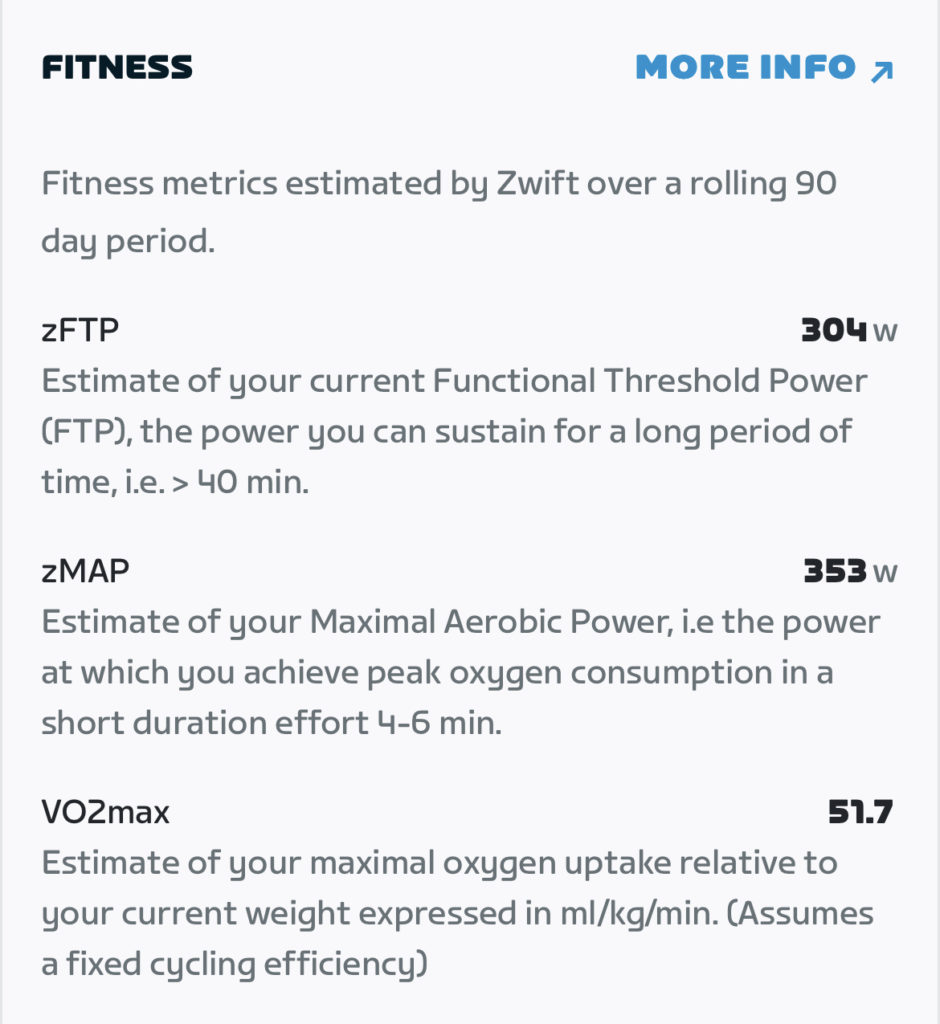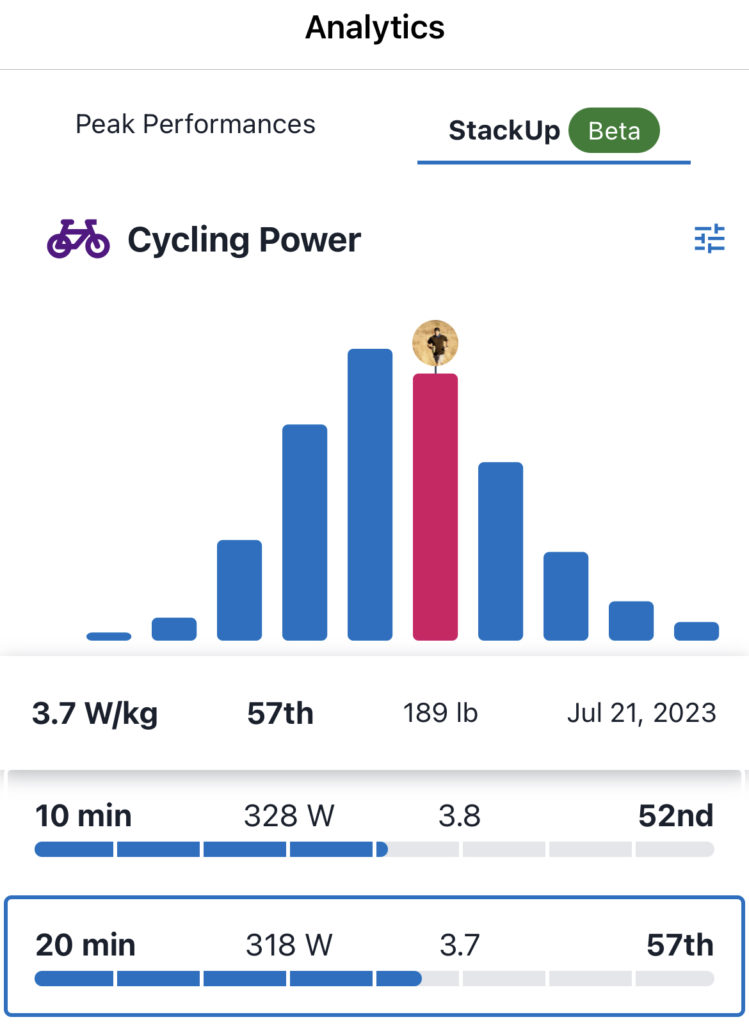Zwift is not the only place where your FTP will be highlighted and used to rate your performance. For many cyclists who are actively training the idea of knowing, and improving, your Functional Threshold Power (FTP) is critical. Zwift uses estimates of FTP in order to rank riders and place them into categories of riders with similar abilities, which helps makes races more engaging.
Training plans use FTP to build workouts and casual chats with riders will often include banter about someone’s FTP. Even the Tour de France coverage and popular media will make comments about a rider’s power and sometimes mention their estimated FTP. While Zwift is a gamified experience and includes a Zwift level, the levels are based on time spent riding and not necessarily overall fitness.

Other training tools also will estimate FTP. We have previously covered how Peloton uses FTP ramp tests in order to develop training zones especially within the Power Zones Training series. Training Peaks, the popular training tool we’ve reviewed, also has inputs for FTP. Strava is yet another one that features FTP estiamte and power curves (although as we noted in our Strava Premium review this is only for the paid tier). Many other tools will also make estimate for FTP, including Garmin devices and a variety of other bike computers.
Average FTP on Zwift and the Bias of Who Ride
The question you really want answered though is what is a good FTP for Zwift? While it depends on what group you look at, our best estimates are that the average Zwift rider has around a 240-260W FTP.
So what do we mean by it depends the the group? ZwiftPower reports 20 minute power increments and notes where that rating (on a raw power and W/kg basis) where you fall in their averages. Of course the average person is not riding on Zwift, so being an average Zwift rider will already separate you from the general population. ZwiftPower is a further opt in, likely skewing even more toward serious cyclists.
So, knowing that we’re looking at an above average sample of the population, on ZwiftPower we can see that 300W total winds up being around 58%. This means that an average rider on ZwiftPower winds up at roughly 280-290W FTP for a 20 min effort which is likely between 3.6-3.9 W/kg. Traditionally we take 95% of this which results in an FTP of somewhere in the neighborhood 260 W.


So how much above average are Zwift riders? While an FTP (or 20 minute power) of 300 on Training Peaks will put you barely above average (57%) the same rate will net you in the top 3% of on Peloton leaderboards. Peloton has more total riders and caters more towards a casual cyclist, but even it is still a subset of people who have opted to spend some money to cycle.
Zwift is similar to Training Peaks in that it is likely to be more associated with serious riders especially compared to something like Peloton (which is available at hotels and community gyms at a much higher rate).

Even within the ZwiftPower tables it is easier to find ways to estimate lower overall power averages. If you look at the largest Zwift Groups (DIRT – Dads indoors riding trainers) there are more than 5000 riders with FTP results. Sort them by FTP ranking and scroll to the 50% and you’ll see an average FTP rating of 240W for a group that is self identified as Dads (likely above the overall average since Males tend to have higher power output).
By all accounts the average Zwift rider is a better cyclist than the average person. So even if your FTP does not seem to stack up well against the group on Zwift, know that among co-workers, friends, and random strangers you will be more of an outlier. Having a good FTP, either absolute or weight graded, also does not always translate to better cycling performance. Everything from gear selection, riding position, terrain, and the environment will impact an individual ride more than FTP.
Zwift FTP test options
The other thing to consider when trying to determine if your FTP is good, is how it was generated. Zwift winds up with a single FTP value but there are multiple ways to get there. These include:
- Automatically from Rides: As soon as you have started riding on Zwift it will begin building a power curve based on your prior 90 day performance. From this curve they can pull an estimated FTP, most often this means taking 95% of your best 20 minute effort. Riders who have done an all out 20 minute time trial, hard long hill climb, or a race out of their comfort zone may get accurate estimates. If much of your riding has been group rides, shorter races where you can ease off and draft in a pack, or workouts without long intervals then this estimate may be very off.
- FTP Test Workouts: Within the workouts sections of Zwift are a number of specific FTP tests. Since many people do not want to do an all out one hour ride, given how stressful it can be on the body, these tests simulate the load with estimates. Either this is done through a hard 20 minute effort, or it is done via a ramp test with progressively harder zones ridden until failure. Each has it’s own benefits (easy to pace while guaranteeing exhaustion) they also can knowingly under or over estimate depending on the type of rider that you are. Still, if you manage to take more than one of these, and have a hard time trial effort from above then Zwift will start to develop a fairly accurate picture of what you can hold.
- Manually Updated FTP: You can plug in whatever FTP you want using personal experience or power meters from other sources. This is helpful if you are doing a workout and want it built to your preferred zones. Especially if you are new to Zwift, and it does not yet have enough data to accurately estimate your FTP, try following the directions to update prior to a ride.
The FTP test and 20 minute efforts are most similar when comparing something like Zwift FTP to Peloton FTP. Still, if you have a known FTP from a lab source, recent race, or alternate power meter it is a good starting point to just manually input the preferred power. Beyond setting workout zones, there is little benefit to knowing your FTP so long as you can listen to your body and not overdo it.